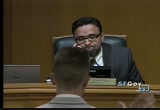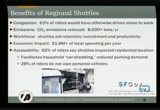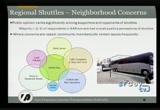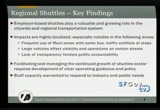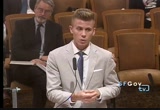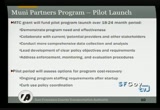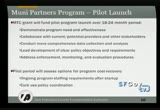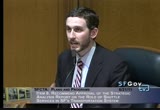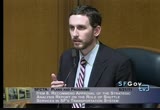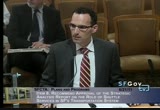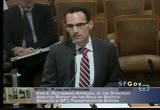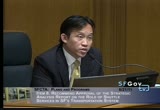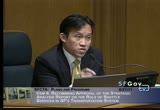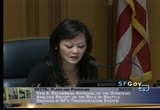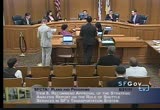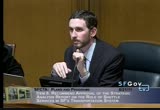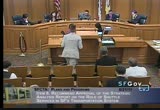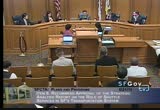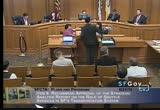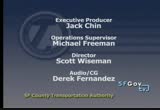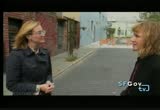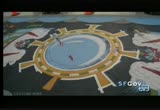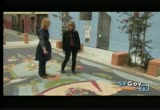tv [untitled] July 5, 2011 1:00am-1:30am PDT
1:00 am
recommendations that are in the report? >> i will address this in a couple of slides in the presentation. two of the approved items were to provide local matches. one of the sub-processes of that effort is to pilot the recommendation. supervisor campos: thank you. >> reviewing the issues associated with that of the shuttle, we wanted to understand the range of benefits and impacts and how some of the concerns raised by constituents and stakeholders on neighborhood impact be address to while maintaining the interests of the sector. in our study in partnership with four major employers we did a survey of passenger shuttles and had a 50% response rate, which was fantastic, calculating the benefits with these original operations in public testimony.
1:01 am
these shuttles provided significant citywide regional benefit in terms of emissions reduction. we found that over 50% of writers would have driven alone to work if the shuttle had not been available. from a workforce perspective the shuttle's aided productivity of the employees and for the employers. we also research to that the shuttle's assisted households in not using their cars as much and getting rid of one or both of their vehicles with benefits for the neighborhood as a whole in terms of reduced parking demand and traffic circulation. we conducted a high degree of outreach targeted to three neighborhoods of concern. where the shuttle operations are
1:02 am
concentrated in the city. we found that public shuttle operation opinion varied significantly, but well over the majority in our efforts had over 800 responses in two types of surveys. in our community meetings there tended to be more voices raised with specific concerns that centered on the operational and highly localized impacts it with disabilities and concerns over emissions and idling with presence of vehicles and muni stops that potentially impact operations if the vehicles are not potentially pulling in. moving on to central planning, the most important one to stress is that the employer based shuttle's play a valuable
1:03 am
role. serving what we would call a choice market of transit riders. folks the majority of whom would not have their needs for alternative transportation met in the city and region. so, they are really allowing for thousands of cars every day to be on the road with of thousands of tons of emissions to be avoided. mentioning the highly localized areas, 90% of the stops used by the regional shuttle were also munis sounds. there may not be an actual conflict. this is an issue that we look that a great deal within the scope upper sar, limited to budget we could not do comprehensive data collection. some of the impact is not as intangible. it may be that both vehicles can fit within the zone but one of
1:04 am
them is not able to pull to the curb. which presents safety concerns. this offer gets at the frustration held by many members of the public regarding contact and reaching out. how do they coordinate with the city or shuttle providers to address specific concerns? in the past we have worked on an ad hoc basis. as you will see in my next recommendation, we are proposing a pilot program to develop operating policy guidelines. supervisor campos: who decides where the stock for the shuttle is? >> currently the provider of the shuttle based on demand fluctuation over time. one thing that we heard from operators of the shuttle was that the ability to adjust that
1:05 am
overtime was very important. and the collaboration where we would seek to maintain that flexibility would also protect others for the use of that curb space, be it muni or otherwise. we want to see the shuttles continue to grow, but in a responsible fashion in line with operating guidance and policy within broader transportation systems. we recommend that the sf mta called muni partner program, involving a designated shuttle point person on staff that would lead that coordination and investigate into public complaints and coordinate with the other related mta policies that are beginning to emerge. other things that are beginning
1:06 am
to look more generally and how we allocate and manage this scarce and valuable resource in the city, that curbs base. -- curb space. an authority led project in collaboration with city departments, we are lucky that the region has stepped up to kick in funding for this project. during this period of the pilot launch, it will take 18 to 24 months. having it funded is really great because we anticipate depth and early portion of the program is when the larger level of effort will aspire work with stakeholders and the wall, the board, the public developing
1:07 am
those policies around where we bought the shuttle's to be and where we do not want them to bqe where it is appropriate for the board to say that this is done can be shared shuttle stop. this one has a bus coming every two minutes. it needs to be extended or the shuttles have to move up one block. coordinating with the police department in evaluation procedures. there has been discussion and concern from providers to extract fees from the shuttle observations. nor the approach that we will be taking during the pilot. this is an opportunity for us to affect ongoing needs for staff as well as how the city wants to
1:08 am
incorporate shells at the curb whether it be ongoing with various stakeholders reporting back to this committee throughout that project. with that i will be glad to take questions. supervisor campos: i think that this is a very useful report and we want to thank the former commissioner for requesting it. thank you for the presentation. well done. any comments or questions? supervisor wiener: and he was well. two of the three focus neighborhoods are in my district. it was a big issue in terms of people concerned about the impact and the many users of the shuttle's lived in my district.
1:09 am
i commend the mta for its work. it is critical that these shuttles continue to exist. in particular i really want to emphasize the importance of routes and stop coordination, making sure -- we should not be regulating these things to death. but right now there is very little coordination. to the extent that the mta can work with those provided to coordinate those shuttles, it would be great for stop coordination. we also need to make sure that most of the shuttles -- not all of them, but most of them are not labeled. i have constituents about --
1:10 am
concerned about shuttles that are not labelled and they had no idea what it was. so, there needs to be an easy way for people to access and to know if there is an issue, which show it is and be able to call one person and interface with that person without the supervisor's office doing random research. in terms of bus stops, i think that it would be a mistake to start creating new buses sounds or extending bus zones for corporate shuttles. i think that that would go over like a lead balloon in terms of removing the significant amounts of parking given the number of spots in one bus zone. but i like a lot of the ideas in this report and am thankful for it. i am curious to know if mta will
1:11 am
be responding today. >> the executive director is here if you have questions. supervisor wiener: i would be interested to know their perspective on this and how they envision moving forward. >> morning, but that peaveys -- directors. -- good morning, directors. to echo what i was saying, these shuttles are a value added benefit to reducing greenhouse gas emissions. let's talk about that some more. what can we do in a city with these shuttles'? we have a small amount of people saying they have concerns with them.
1:12 am
with that, we are looking at the current regulatory permit that we have to determine the best used in terms of the overall transit system that we have, looking at a way to make them a part of the transportation system. as you mentioned, people do not know what they are. there has been initial concern by shot providers do not identify themselves because they constantly change their route. at that time it is time to explore better identification. for the residents that use? , where do they stop? one question that we have had as a part of this, we received a grant from the mtc and hired a transportation project manager for issues in the city. one of their key talents is working on this program.
1:13 am
one thing to look at and explore as a city is that as we work closely with shuttle providers, their role in the transit system is going to open up policy issues. you cannot ride on the shelves to use these services. the shuttles are in place with development agreements a few years ago, recent trends have gone in to make them duplicative. there are customer markets that some providers believe are not interested or willing to use the system. we will have to look at these broader issues and what makes sense in terms of how we have them, as partners in the transportation system.
1:14 am
we want to be very cautioned and saying that we are not using this as an opportunity to charge an extra fee. in terms of time loading allocation, what would make sense now? exploring all of the options. ." supervisor campos: thank you. supervisor chiu: i had a couple of questions. from my perspective, and many of us see it this way, san francisco is becoming a veteran community for silicon valley. every day we have tens of thousands of san franciscans going to work in silicon valley. as a city we have to think about what we can do to keep these companies here. we have lost hundreds in recent
1:15 am
years because of other city policies. putting that aside, let's talk about transit for a moment. it is my perspective that these shuttles are good things. we understand the impact of private cars on the streets and we want to make sure the shuttle services being provided continue. but there must be an appropriate level of regulation. i think that many of us have districts where we have seen the proliferation of these to our bosses. understanding exactly where these routes are is helpful. i would like to ask the various companies that provide these shuttles to be in more explicit contact with the city. i would like to specifically thank a google who has reached out to was to think this through. i know that many constituents
1:16 am
wonder what the better suggestions are and we do not know who to provide this is used to. one other issue that i would hope that the mta things about is how this intersects with our tour bus industry. from the tourism industry my district in particular -- i received countless complaints from constituents about the relatively unregulated situation that confronts tourism -- tour bus is related to tourism. while but -- while that is also something that we would like to see as it intersects with how shuttle buses work in the city being good, i think that you know that my office has asked the mta to provide a tour bus policy to better proliferate the regulation of these tour buses
1:17 am
and figuring out how that intersects with each shuttle buses will be important as well. >> she has a very good plan this year and it is a good way to look at getting off that policy. >supervisor chu: the questions and comments that were made already covered by topics. quickly, the importance that the supervisor made in terms of the additional parking issue is not lost upon us. because of the benefits of the shuttle program we would not want to do something that could harm that cordis incentivize companies from providing the shuttle's. that is an important concept and i appreciate the comments that were made. i think that one of these photographs really shows something that looks more like a tour bus and often around city hall we see those kinds of conflicts. to the extent that that could be
1:18 am
factored in would be helpful in certain areas of our city. >supervisor wiener: i really want to emphasize, at least for myself, and i agree with supervisor chu and the public at large, in my view these corporate shells are extremely important. they provide a huge service to a lot of residents in san francisco. they reduce congestion on our roads. of course we all have constructed -- constructive criticism and ideas to make it better, but i think it is so important not to make them less accessible for the residents of san francisco that depend on them every day. i also find it appropriate to explore the tour bus issue, but
1:19 am
i do not want to lump in corporate buses and or bus shuttles together. they are very different in terms of their respect for this to the city. nothing is perfect, but my experience in general has been that other than the size of the buses, causing the issue -- we had one for a long time that was literally stopping at castro and blocking entire crosswalks while tourists went around the neighborhood and it was impossible to get them to stop. it is really apples and oranges, although it is important to explore that issue. supervisor campos: staff with anything else to add? i would like to thank staff for the great work and presentation. i hope that this is an item that we will bring back to the
1:20 am
committee so that we get an update on where things are. i think that the goal is to strive to balance to work with these companies providing this essential service in a way that these consumers in san francisco have issues with. let's open it to public comment. please come forward. >> i want to say thank you to everyone who understands the huge benefit of the shuttles. supervisor campos: speak into the microphone, please. >> a lot of the information provided is very outdated. it is from late 2008, early 2009. if you look at shuttle usage, it has gone up significantly but the number of complaints have
1:21 am
dropped over time. there is not a direct correlation between the number of complaints and the number of shuttle riders. some complaints started before companies understood all of the impact. muni first, we immediately get out of the way when there is a bust their. i understand they are happy to work with them but i think that the four recommended a program. supervisor wiener: [inaudible] >> veronica from google. supervisor wiener: all of the corporate shells are in and out much quicker than the others. there are probably a number of reasons for that i do not recall
1:22 am
ever seeing one of them spending an undue amount of time at the bus stop. >> companies that run shuttles have committed to less than three minutes and have made efforts to make a boarding better. supervisor campos: maybe it is not just about providing feedback to companies. maybe it is learning from practices. >> we would be more than happy to work with you on that. supervisor campos: any other member of the public debt with like to speak? seeing no one, public comment is closed. we have a recommendation to approve the report. if we can have a motion on that? motion by supervisor chiu. supervisor chu: quick question. given the comments that were
1:23 am
made about the report and how the information is dated in terms of what we are experiencing, there were recommendations provided here that work pretty broad. i am imagining that there will be some conversations between providers, muni, and as we go forward there is nothing set in stone about a shuttle program at this moment. >> which encapsulates the first part of our work on the partner program, updating disinformation. some of that data lead was due in part because of the report itself coming up when it was. last summer we secured that funding to move the project forward. supervisor chu: thank you. supervisor campos: we will bring back this item to see where things are. motion and a second, taken without objection?
1:24 am
can you recommend approval of the strategic analysis report? >> i think that you raised this issue earlier, but what does approving it mean? it is still not clear to me. there are great ideas in here. supervisor campos: my idea is we simply accept the risk for -- the report. is there a separate meeting? >supervisor chu: this is taking a step to exploring the pilot through recommendation. >> is sf mta in agreement? supervisor chu: they are a full partner. >> wanted to make sure i was on the same page. supervisor wiene>> while the mte
1:25 am
grand, all of the pieces will be led by them. supervisor campos: we take that without objection. thank you again. we will come back to this item in a few months. please call item no. 9. >> information item, introduction of new items. supervisor campos: with any member of the public like to speak? seeing no one, public comment is closed. item number 10. >> public comment. supervisor campos: this is an opportunity for members of the public to speak off the agenda. seeing no one, public comment is closed. please call the last item. let's item number 11, and -- >> item number 11, adjournment. supervisor campos: thank you very much. meeting adjourned the.
1:26 am
>> hello. welcome to "culturewire." we are here today with bay area artist jody chanel, and we are here to see the plaza where your piece has just been installed. >> i have been doing large-scale paintings in the galleries and museums, and the idea that in the future, i could do something that would hang out a little bit longer than the duration of the installation the kind of appeal to me. i quickly found out about the san francisco arts commission school and realized there was a pre-qualified school you had to apply to, so i applied to the. >> how long did it take you to develop this work for the plaza?
1:27 am
>> this was a fast track project. design development was about a month. >> let's look at the beautiful mural. i have never seen a mural created on asphalt. >> the heat of the asphalt, a new layer of asphalt. then, these wire rope templates that were fabricated for the line work get laid down and literally stamped into the asphalt, and then everything was hand-painted. >> maybe you could talk about some of the symbolism, maybe starting in the middle and working out. >> [inaudible] the flower of industry. >> it is like a compass. there's an arrow pointing north. >> within the great bear consolation, there are two pointed stars here.
1:28 am
they typically lead one to the northstar, otherwise known as polaris. so i thought it has a layer of theme. >> let's talk about some of the other elements in the peace. we are walking along, and there is a weather vane. there's a sweet little bird hanging on the side. what kind of bird is that? >> [inaudible] the smallest of the gulf species, and it lives around the bay area. >> you want to talk about the types of flour patterns that you send? >> [inaudible] around 1926 or so by the dahlia society. >> what is this bird here? >> that is the california quail. >> coming up here, we had a little blustery theme.
1:29 am
what is this area here? >> this is supposed to be the side view, the expense of the golden gate bridge. >> there it is. >> there are really beautiful elements of architecture still around, i would say that it gives that feeling over to the work. >> what are your hopes for it? >> that in a way it just becomes part of the area. i think it is starting to have that feeling. people utilize it. they sit and, and have their lunch and play on -- they sit and, and have their lunch and play on that -- they sit and come and have their lunch and play on it. just for it to be part of the neighborhood. that is my hope. >>
95 Views
IN COLLECTIONS
SFGTV: San Francisco Government Television Television Archive
Television Archive  Television Archive News Search Service
Television Archive News Search Service 
Uploaded by TV Archive on

 Live Music Archive
Live Music Archive Librivox Free Audio
Librivox Free Audio Metropolitan Museum
Metropolitan Museum Cleveland Museum of Art
Cleveland Museum of Art Internet Arcade
Internet Arcade Console Living Room
Console Living Room Books to Borrow
Books to Borrow Open Library
Open Library TV News
TV News Understanding 9/11
Understanding 9/11